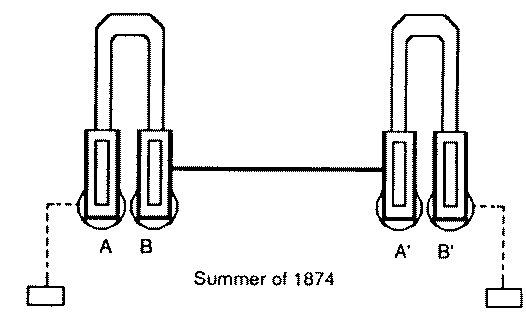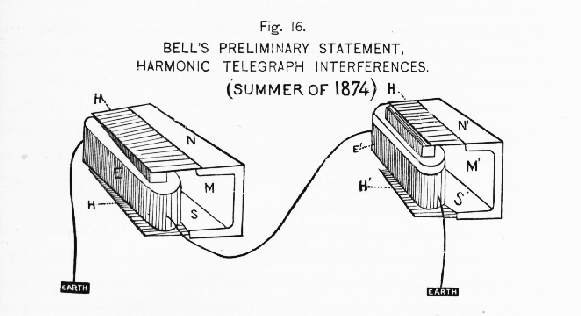





 Figure 15, from Bell's The Multiple Telegraph. Summer of 1874
Figure 15, from Bell's The Multiple Telegraph. Summer of 1874 This device represents an entirely different mental model for the system, and it utilizes Bell's knowledge that he may have received from the works of DuMonceil.
Bell decides that using the battery in the previous circuits creates a device that is overly complicated, and thus, he decides to remove the voltage source from the system.
The necessary induced impulses are now created by means of a permanent magnet instead of the battery. "When a permanent magnet is caused to approach the pole of the electro-magnet, a current of electricity is induced in the coils of the latter; and, when it is made to recede, a current of opposite polarity to the first is induced in the electro-magnet. Therefore, the vibrating permanent magnet in front of the pole of the electromagnet produces an oscillating or undulating current in the coils.
In this physical system, AB, A'B', are steel reeds attached to permanent magnets MM'. The poles of the electromagnets are EE'. A and B are of different pitch, and A' and B' are their exact counterparts. When A is made to sound a musical note, A' is thrown into vibration. In this instance, neither B nor B' are affected. Bell found that the polarity of the induced response depended upon the direction of motion of the permanent magnet, which also corresponds to the condensation or rarefaction of air.
Perhaps the most significant feature of this device is its ability to resound at particular pitches , or rate of vibrations,as well as adjustable loudness, or amplitude of vibrations. In other words, if the transmitting A was at a certain loudness, than the A' resounds at the same volume.
The combination of reeds was also important for Bell. A and B would vibrate at a different pitch; Bell was interested in what would happen when each reinforced the others vibrations, vs. when one acted to partly cancel-out the other (see Deposition, p. 33). Therefore, the sinusoidal curves produced by each reed could be summed, to create the curve that was represented in Figure 4 of Bell's March 7 patent.
 Harp Apparatus
Harp Apparatus In the summer of 1874, Bell sketched a device consisting of a series of steel reeds over a single electromagnet. The principle is the same as in Figure 15, but it differed in that Bell replaced the single reed over each pole of the electromagnet with a large number of reeds. Like the strings of a piano, these reeds would reproduce musical tones. When one spoke a vowel into the transmitting harp, Bell visualized how a combination of reeds representing the fundamental tone and its overtones would vibrate and this exact combination would be transmitted to the other side, reproducing the vowel sound. This principle had been clearly established by the Helmholtz device which was Bell's original mental model; in this case, however, the single interrupting fork and series of separate resonators were replaced by a series of reeds combining to induce a current in a single electromagnet.
Bell knew he could never build such a device, owing in part to the multiplicity of reeds that would be required, but it served as a new mental model for a universal transceiver -- this harp apparatus could transmit and receive speech, musical tones, or any other pattern of sounds.